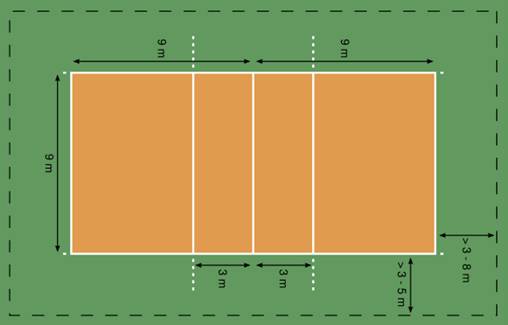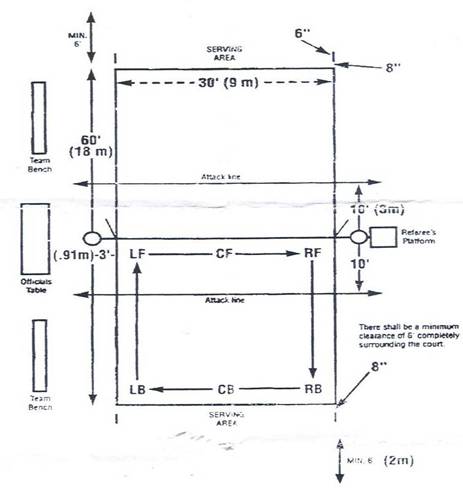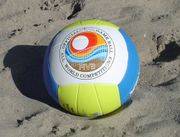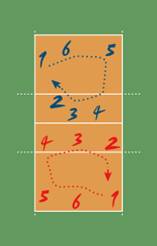


Playing area
The playing area includes the playing court and the free zone. It shall be rectangular and symmetrical.
DIMENSIONS
The playing court is a rectangle measuring 18 x 9 m, surrounded by a free zone which is a minimum of 3 m wide on all sides.
The free playing space is the space above the playing area which is free from any obstructions. The free playing space shall measure a minimum of 7 m in height from the playing surface.
For FIVB World and Official Competitions, the free zone shall measure a minimum of 5 m from the sidelines and 8 m from the end lines. The free playing space shall measure a minimum of 12.5 m in height from the playing surface.

PLAYING SURFACE
The surface must be flat, horizontal and uniform. It must not present any danger of injury to the players. It is forbidden to play on rough or slippery surfaces.
For FIVB World and Official Competitions, only a wooden or synthetic surface is allowed. Any surface must be previously approved by the FIVB.
On indoor courts the surface of the playing court must be of a light colour.
For FIVB World and Official Competitions, white colours are required for the lines. Other colours, different from each other, are required for the playing court and the free zone.
LINES ON THE COURT
All lines are 5 cm wide. They must be of a light colour which is different from the colour of the floor and from any other lines.
Boundary lines Two sidelines and two end lines mark the playing court. Both sidelines and end lines are drawn inside the dimensions of the playing court.
Centre line
The axis of the centre line divides the playing court into two equal courts measuring 9 x 9 m each; however the entire width of the line is considered to belong to both courts equally. This line extends beneath the net from sideline to sideline.
Attack line
On each court, an attack line, whose rear edge is drawn 3 m back from the axis of the centre line, marks the front zone. For FIVB World and Official Competitions, the attack line is extended by the addition of broken lines from the sidelines, with five 15 cm short lines 5 cm wide, drawn 20 cm from each other to a t
Teams:
Teams consist of up to 12 players with 6 on the court at any time. Each player must rotate (clockwise) every time their team wins back the service from the opposition . only the three players at the net position can jump and spike or block near the net . the backcourt players can only hit the ball over the net if they jump from behind the attack line also known as the three – meter line wish separates the front and back part of the court.
Rally:
A team can touch the ball three times on its side of the net. the usual pattern Is a dig (an underarm pass made with an withwith the forearms) a set (overhead pass made with the hands) and a spike (the overhead attacking shot). The ball is served into play. Teams can also try to block th t' ik th t bl k i tthe opponent's spike as it crosses the net. A block into your own court does not count as one of your three touches.
The rally will be stopped By the umpire 's whistle if the ball:
_ does not travel over the net after three hits
_ does not land in the opponents court
-land in the teams own court
_ hits the ceiling
*if a player carries, catches, throws, lifts or double touches the ball
*if a player touches the net or crosses the centre line (player may step on the line but not over) *if a team commits a rotational error
*if a backcourt player spikes or blocks out of position (in the front court)
Scoring:
The rally system. Every rally would now earn a point The four 25a point. first sets are played to 25, but the winning team must by at least two points. The played 15-fifth set is to 15 and again the winner must have a two-point margin.
Matches:
Matches are played best of five sets. The first four sets are played to 25 points, with the final set being played to 15 points. A team must win a set by two points. There is no ceiling, so a set continues until one of the teams gains a two-point advantage. Previously, all sets were to 15 points, with the first four sets having a ceiling of 17 and the final set requiring at least a two-point winning advantage .
Service:
Each rally commences with a serve (after the ump he's whistle) at any point behind the baseline. To bc a legal serve the ball must be thrown up before being struck with an open hand, clenched fist, wrist or heel of the hand. Each player gets only one chance to serve. A legal serve can touch the net and continue into the opponent's court. When the serving team loses a rally, it loses the receiving team then rotates at one position on the court.
The ball:
After testing many colours, the FIVB introduced a ball with yellow, blue and white panels at the world championships in Japan in 1998. it replaced the traditional all-white ball .

Libero:
In 2000 FIVB introduced a new specialist role role: the libero. This player wears a different coloured uniform from the rest of the team and can be substituted in backcourt for any player on the team. The libero cannot serve, spike the ball over the net or rotate into the front-line positions, but plays a vital role for the tame in serve reception and backcourt defence. if the libero Makes an overhead set of the ball in front of the 3m attack line, the ball may not be spiked over by the team. If the libero makes the same action behind the front zone, the ball may be freely attacked. There over by at least one point played between a libero substituting off for a player and going back on the court for another player-hence he cannot be on the court for the whole game.
Rotation:
Each of the six players on an indoor team rotates a position after winning back service from the opponent. This is key to the tactics of indoor volleyball-you cannot simply keep your best blockers and spikers at the net or your best defenders in backcourt. After serving from players rotate to six (middle back), then position five (left back). Position four (left front), position three (middle front) and position two (right front) before returning to serve.

Substitution:
Up to 6 subs may be each side per set, hence a maximum of 12 players per side.
TIME-OUTS AND TECHNICAL TIME-OUTS:
All time-outs that are requested last for 30 seconds. For FIVB World and Official Competitions, in sets 1-4, two additional 60-second “Technical Time-Outs” are applied automatically when the leading team reaches the 8th and 16th points.
In the deciding (5th) set, there are no “Technical Time-Outs”; only two time-outs of 30 seconds duration may be requested by each team.
During all time-outs, the players in play must go to the free zone near their bench.
